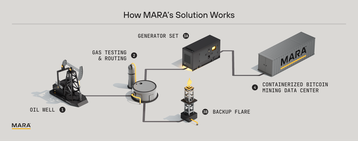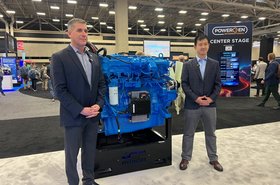Cryptocurrency firm MARA has fully energized a 25MW modular cryptomine data center powered by flared natural gas in Texas and North Dakota.
The project was implemented in partnership with on-site mitigation services provider NGON and was originally signed in October of last year.
The data center has been in semi-operation for five months and is distributed across a range of wellheads in Texas and North Dakota.
Speaking to DCD, Adam Swick, chief growth officer at MARA, said that the flexibility of digital assets [crypto] was a huge factor in the project's success, stating: "The fact that we mine digital assets gives us a unique opportunity to bring our operations directly to where the energy is generated. This is something that traditional data centers can’t easily replicate because of their grid reliance and high uptime requirements."
According to MARA, the 25MW of new capacity currently delivers the lowest energy cost per Bitcoin mined across its entire global fleet, which totals around 1.7GW.
MARA says that, at full capacity, its current gas-to-power network consumes 5,000 cubic feet of associated gas per day. Through routing the gas via power generation infrastructure, the company claims it increases the combustion efficiency of the flared gas to 99 percent, compared to 92 percent for the average flare.
Following the successful energization of the assets, MARA now has an operational portfolio of 139MW of self-owned assets. Natural gas powered data centers make up 18 percent of the portfolio, with the remaining made up of wind power generation.
Last December, the company acquired a 114MW onshore wind project in Hansford County, Texas, with the intention to develop a behind-the-meter Bitcoin mining operation on the site.
Companies involved in using flared gas to power servers claim the process benefits the environment because otherwise wasted energy is used, and the gas is burnt more efficiently, releasing less unburnt methane. However, it helps increase the revenues of gas projects, helping fund more fossil fuel development.
The practice has grown in popularity within the crypto and data center space over recent years, buoyed by new legislation such as the Flare Act, passed in March, which incentivizes entrepreneurs and crypto miners to use natural gas that would otherwise be stranded.
In the same month, HNO International launched a new division, EcoFlare Power, to harness flared natural gas to power high-performance computing (HPC) data centers and Bitcoin mining operations.
In November last year, Hilcorp announced a pilot project to test the feasibility of using natural gas from Alaska’s North Slope oil and gas fields to power a Bitcoin mining operation.
Earlier in the same month, Hyperscale Data launched a separate pilot project to explore the feasibility of Bitcoin mining powered by natural gas turbines operated by an undisclosed project partner.







